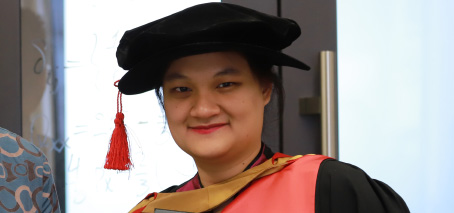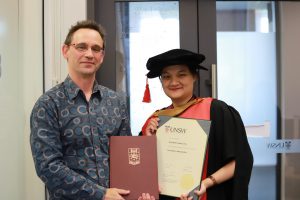Maths and spin: key to new electronics
A love of maths brought Elizabeth Marcellina to the study of quantum and condensed-matter physics, where her recently completed PhD research studied possible routes to faster, more efficient electronics, by harnessing the ‘spin’ of the carriers in common semiconductors.
As Moore’s law is coming to an end, much effort has been devoted to explore new ways of manipulating information in semiconductors with less energy consumption. One way is to use the magnetic properties (i.e. ‘spin’) of semiconductor carriers, combined with conventional electronics.
We asked Elizabeth some questions about her research and her thesis, “Spin-orbit interactions in low-dimensional semiconductor holes.”
Q: What did you do?
EM: I studied the spin-orbit interactions in semiconductor holes. Particularly, I wanted to understand the strengths of these interactions and how much we can ‘tune’ them in semiconductors.
Q: Why is this important?
Spin-orbit interactions allow all-electrical control of spins. So understanding these interactions is really the key to realising semiconductor spintronics.
Q: Spinwhatnow? What is that, and why is it cool?
Semiconductor spintronics is a really promising solution for the imminent breakdown of Moore’s law.
Spin is an inherent angular momentum in particles such as electrons, or holes (essentially, the absence of an electron). It’s an extra degree of freedom on top of the charge-carrier’s charge, which is what gives the 1s and 0s in traditional electronics.
Spin-orbit interactions allow all-electrical control of spins, which is why I was studying them.
Q: How does your research this fit in to the larger picture within FLEET?
FLEET aims to develop low-energy electronics to address the breakdown of Moore’s law. My research gives insights as to how semiconductor holes could be a platform for these low-energy electronics.
Q: What got you into this field?
I have always enjoyed the mathematics of quantum and condensed matter physics since a lot of equations can be derived from a single formula (eg, the Schrödinger equation) and they are interrelated. So, I chose semiconductor physics research as it is a great platform to appreciate the mathematical workings of quantum and condensed matter physics.
Q: What next for you?
I am going to do more research on other two-dimensional semiconductors in my next stint at NTU Singapore (actually I started 3 days ago).


